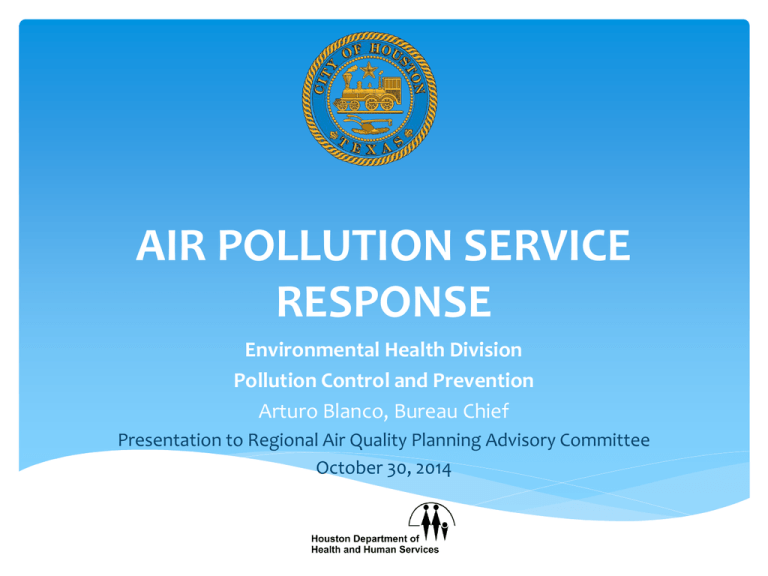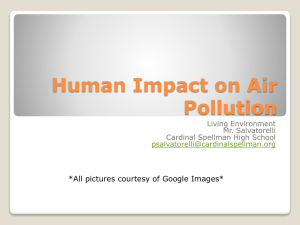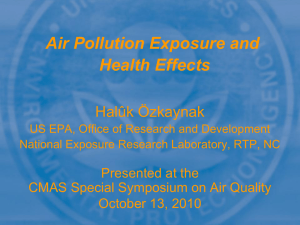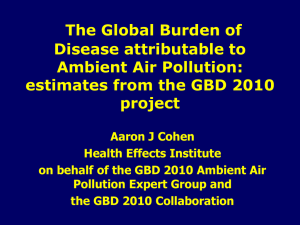Air Pollution Service Response
advertisement

AIR POLLUTION SERVICE RESPONSE Environmental Health Division Pollution Control and Prevention Arturo Blanco, Bureau Chief Presentation to Regional Air Quality Planning Advisory Committee October 30, 2014 Content Air Complaints One Pagers Community feedback Area Surveillances Monitoring air pollution trends Metal Recyclers Outreach at schools EPA Village Green Project Air Complaints Air Complaints Type, Effects, and Monthly Distribution One Pagers • Synopsis of environmental data collected and complaints serviced in neighborhoods that have reached out to BPCP for support, information or help to address environmental concerns affecting their communities. • Through Houston Community Health Improvement Plan (CHIP) partnership with Air Alliance Houston, we work to promote environmental health resources, respond quicker to pollution concerns of highest importance to our neighborhoods, and expand community level of knowledge about air quality, its threats to public health and minimize exposure. One Pagers Mobile Ambient Air Monitoring Laboratory (MAAML) Community Feedback Within the past two years, community leaders in these Super Neighborhoods have expressed environmental concerns and requested fixed air monitors to monitor ambient air. • Surrounded by industrial warehouse district and industrial rail lines on Pleasantville’s north and south boundaries. • Reported pollution from Ship Channel industry looming over their homes, ranging from petrochemical to metal recycling activities. • People observed catching and reportedly eating fish from nearby waterways not suitable for recreational contact. • Nearby industry and commercial activities generated from Houston Ship Channel are of high concern. • Reported pollution from traffic and trucks along roads and freeways with numerous surrounding small businesses. • Environmental complaints include diesel fumes from trains and trucks and chemical packaging transfers. • 1995 seven-alarm warehouse fire smoked for weeks with lasting environmental uncertainties and fresh in their memories: • 45 warehouses sit within 1,000 feet of residences • 516 locations with hazardous chemical storage and handling permits • Formerly the site of Holmes Road landfill and a waste incinerator on Bellfort St. near HWY 288. • Reported pollution from multiple sources and blight including metal and concrete crushing sites, surface coaters, and “abandoned” businesses. Area Surveillances • Maintaining vigilance in areas of Houston where residents live, frequently expressing poor air quality concerns due to nearby industry. • Randomly doing surveillance of prioritized areas with frequent complaints and unresolved sources of nuisance odors with ongoing intermittent problems. • Areas of interest are integrated into the investigator’s workload of field activities; investigators use wide array of air monitoring tools. • Attention and resources are focused on specific symptoms such as variable odors periodically detected in the East End or 610 south central. • While less frequent, surveillance sometimes result in observations of trailing smoke from a flare and invisible emissions seen with the help of IR camera. Area Surveillances Tank emissions discovered during surveillance on October 2013. • Investigators map a plan of action insuring that upwind and downwind monitoring is conducted and results discussed to formulate next steps. • Surveillance initiatives are usually in industrial areas. • In recent years we have turned attention to gasoline dispensing facilities and auto dealers, focusing on air pollution, as well as runoff fluids with potential impact to storm drains. • Most surveillance resources have been focused during the day; sometimes at night. We have worked with concerning sources with and without formal enforcement depending on each situation. Tank was placed out of service on October 2013, and remains out of service as of October 2014. • As resources allow, our surveillance program varies based on overall routine demands including emerging requests for public pollution assistance, varying density of complaints, and other prioritized work during and after normal work hours. Ambient air monitoring trends of air pollutants PM2.5, PM10, Benzene, Styrene, 1,3-Butadiene, Toluene, Propylene, etc. • BPCP meets periodically with the management team of chemicals companies, refineries and other types of regulated entities in an informal and cooperative spirit with goal to improve air quality. • BPCP shares charts of ambient air monitoring that may show trend of increasing or decreasing concentrations of air pollutants, relevant air complaints received, emission events, and possible or actual enforcement issues. • The companies introduce any changes in their teams, update on status of improvements and share environmental projects of germane interest. Ambient air monitoring trends of air pollutants PM2.5, PM10, Benzene, Styrene, 1,3-Butadiene, Toluene, Propylene, etc. Metal Recycling Process Issues • Torch Cutting [metals, Particulate Matter (PM), odor, fire] • Shredding [PM, metals, Volatile Organic Chemicals (VOCs), explosions] • Shearing (PM, metals, noise) • Crushing (PM, VOCs, explosions) • Conveyors (PM, noise) • Materials handling (PM, metals, Storm Water Runoff or referred to MS4 in Houston) • Unpaved areas (PM, MS4) • Runoff (metals, organic fluids) • Fluid transfers [Freon, BTEX, VOC & Semi-Volatile Organic Compounds (SVOCs) emissions, spills and fire] • Equipment emissions [Nitrous Oxides (NOx), diesel PM, BTEX] What We Found • Cd, Cr & Pb associated with metal coatings • Elevated Fe at all ferrous metal sites and Co, Cr, Mn & Ni with ferrous alloys and stainless steel processing • Cu, Co, Cr, Mn & Ni associated with nonferrous processing • Ag associated with a Ag reclamation facility • BTEX, Freon and other VOCs associated with sites accepting vehicles, appliances & used 55 gallon drums, notably elevated levels when such items are shredded without a bag house Building Partnerships to Respond Task force between metal recycling trade groups and Houston Health & Human Services Department Community-Academic Coalition established to secure federal funding to support a collaborative effort Academics, Houston Health & Human Services Department, Air Alliance Houston, Metal Recyclers, and Neighborhood Residents Air Monitoring and Outreach at Schools Measurements have found no significant concerns EPA Village Green Project • An innovative, solar-powered air-monitoring system designed and incorporated into a park bench • It will measure real-time Ozone, PM2.5 and weather conditions • City of Houston is coordinating with EPA future placement of Village Green monitor Source: http://villagegreen.epa.gov/ Thank You! Bureau of Pollution Control and Prevention Main: (832) 393-5730 Complaints: 311 Website: http://www.houstontx.gov/health/bureau-pollution-control-and-prevention-bpcp









